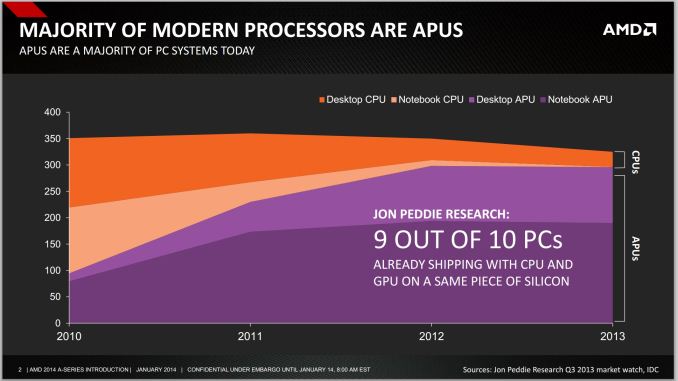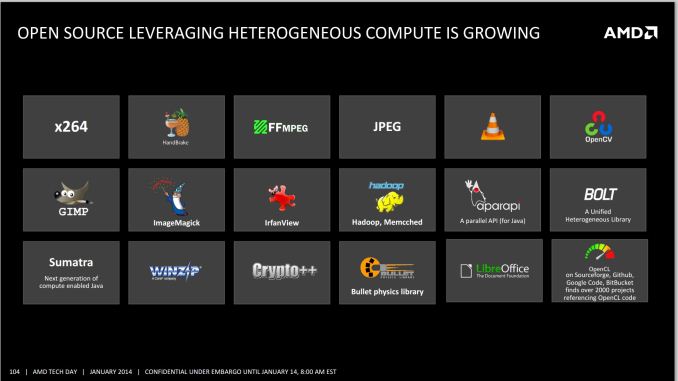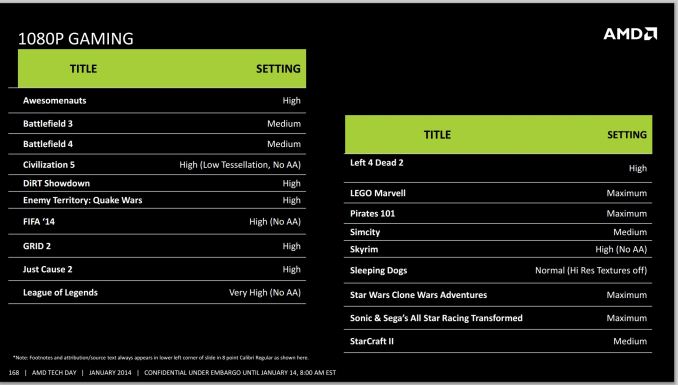AMD Kaveri Review: A8-7600 and A10-7850K Tested
by Ian Cutress & Rahul Garg on January 14, 2014 8:00 AM ESTKaveri: Aiming for 1080p30 and Compute
The numerical differences between Kaveri and Richland are easy enough to rattle off – later in the review we will be discussing these in depth – but at a high level AMD is aiming for a middle ground between the desktop model (CPU + discrete graphics) and Apple’s Mac Pro dream (offloading compute onto different discrete graphics cards) by doing the dream on a single processor. At AMD’s Kaveri tech day the following graph was thrown in front of journalists worldwide:
With Intel now on board, processor graphics is a big deal. You can argue whether or not AMD should continue to use the acronym APU instead of SoC, but the fact remains that it's tough to buy a CPU without an integrated GPU.
In the absence of vertical integration, software optimization always trails hardware availability. If you look at 2011 as the crossover year when APUs/SoCs took over the market, it's not much of a surprise that we haven't seen aggressive moves by software developers to truly leverage GPU compute. Part of the problem has been programming model, which AMD hopes to address with Kaveri and HSA. Kaveri enables a full heterogeneous unified memory architecture (hUMA), such that the integrated graphics topology can access the full breadth of memory that the CPU can, putting a 32GB enabled compute device into the hands of developers.
One of the complexities of compute is also time: getting the CPU and GPU to communicate to each other without HSA and hUMA requires an amount of overhead that is not trivial. For compute, this comes in the form of allowing the CPU and GPU to work on the same data set at the same time, effectively opening up all the compute to the same task without asynchronous calls to memory copies and expensive memory checks for coherency.
The issue AMD has with their HSA ecosystem is the need for developers to jump on board. The analogy oft cited is that on Day 1, iOS had very few apps, yet today has millions. Perhaps a small equivocation fallacy comes in here – Apple is able to manage their OS and system in its entirety, whereas AMD has to compete in the same space as non-HSA enabled products and lacks the control. Nevertheless, AMD is attempting to integrate programming tools for HSA (and OpenCL 2.0) as seamlessly as possible to all modern platforms via a HSA Instruction Layer (HSAIL). The goal is for programming languages like Java, C++ and C++ AMP, as well as common acceleration API libraries and toolkits to provide these features at little or no coding cost. This is something our resident compute guru Rahul will be looking at in further detail later on in the review.
On the gaming side, 30 FPS has been a goal for AMD’s integrated graphics solutions for a couple of generations now.
Arguably we could say that any game should be able to do 30 FPS if we turn down the settings far enough, but AMD has put at least one restriction on that: resolution. 1080p is a lofty goal to hold at 30 FPS with some of the more challenging titles of today. In our testing in this review, it was clear that users had a choice – start with a high resolution and turn the settings down, or keep the settings on medium-high and adjust the resolution. Games like BF4 and Crysis 3 are going to tax any graphics card, especially when additional DirectX 11 features come in to play (ambient occlusion, depth of field, global illumination, and bilateral filtering are some that AMD mention).













380 Comments
View All Comments
mr_tawan - Tuesday, January 14, 2014 - link
I'd love to see how it works with another dGPU, like R7.Also, it might be interesting if we could utilize GPU in the APU and the GFX card at the same time, for different things. For example, the GPU in APU works on the OpenCL/Computing stuffs while the dGPU works on the graphics exclusively.
It looks like many AT readers do not realize how significant HSA has brought. Well based on the current software ecosystem we don't see any advantage over the ordinary CPU+GPU combination. AMD have to work really hard to get developers on board, otherwise they are done for.
iTzSnypah - Tuesday, January 14, 2014 - link
Why didn't you include any memory overclocking? The only thing I am interested in knowing is if AMD has fixed their controller so you can actually run high speed RAM (2400+).schizoide - Tuesday, January 14, 2014 - link
I'm frankly astonished they DIDN'T introduce essentially the PS4 APU with Kaveri. CPU actually doesn't matter much for gaming and a pricepoint around $300 would be no problem at all. I'd buy one and build a HTPC/steambox around it in a hot second.Very disappointed that AMD didn't do this. It seemed like such an obvious path.
thomascheng - Tuesday, January 14, 2014 - link
I think it would be a different story if they showed some really HSA or Mantle programs, but they launched a product where the big selling point is HSA and Mantle. Mantle would have been a big win for them in battlefield 4, but that got delayed and there no HSA programs. I think next year they will be in a much better position.schizoide - Tuesday, January 14, 2014 - link
If mantle ends up being meaningful, and if HSA gains are tangible, perhaps. But even with a 45% speedup Kaveri can't compete with the ~7870 in next-gen gaming consoles, and that renders it unacceptable as a gaming solution.thomascheng - Tuesday, January 14, 2014 - link
I agree for hardcore gamers, but I believe ExtremeTech showed a chart saying that 1/3 of all gamers are using Intel chips with iGPU for gaming, next would be intel chips with mid level Nvidia/AMD dGPUs. I think this chip is for those 2 crowd. The apu won't beat the mid to upper crowd and it's really not designed for them.schizoide - Tuesday, January 14, 2014 - link
Don't see how, as it doesn't remotely compete with even <$100 discrete GPUs. It's simply not a competitive gaming solution at any level past facebook games and ports from the previous console generation.silverblue - Tuesday, January 14, 2014 - link
A bit unfair considering the chip just launched and drivers will improve in time. What's more, if we were to assume the GPU was equal to, say, an $80 card, this means a $90 CPU, and how many $90 CPUs will realistically beat this?The real disappointment here is not seeing what the new APIs really do for Kaveri, so we're left guessing.
jrs77 - Tuesday, January 14, 2014 - link
AMD X4-760k + HD7750 1GB GDDR5 will beat the Kaveri at every task costing the same. jfyitakeship - Tuesday, January 14, 2014 - link
Most Celeron, all Pentiums based on Sandy Bridge will own Kaveri at all but heavily threaded tasks. As above, a HD7750 or R7 240, especially if it's GDDR5, will slaughter Kaveri in FPS.